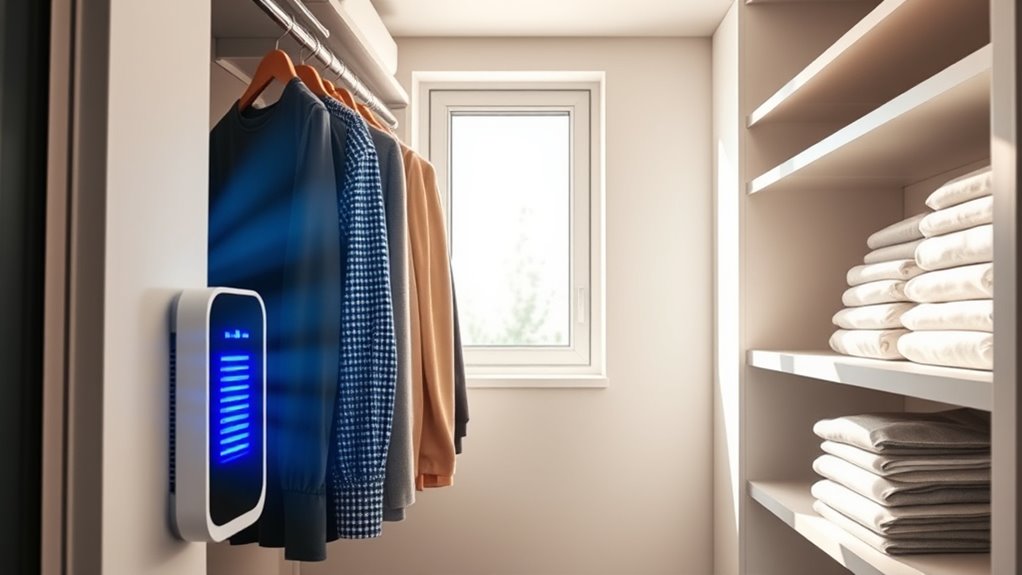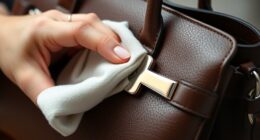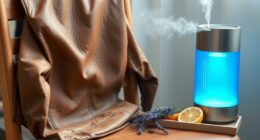To prevent mold in your closet, use a dehumidifier to keep humidity below 60%, which inhibits mold growth. Make certain proper ventilation by installing vents or leaving doors slightly open, and use exhaust fans if possible. Regularly monitor humidity levels with a hygrometer, and store clothes in airtight, moisture-proof containers. Address leaks and water damage promptly, and keep the space clean. For more effective dehumidifier hacks, continue exploring these simple, impactful strategies.
Key Takeaways
- Use a dehumidifier to maintain humidity levels below 60%, preventing mold growth.
- Place silica gel or activated charcoal packs in closets to absorb excess moisture.
- Ensure proper ventilation by installing vents or leaving doors ajar for airflow.
- Regularly monitor humidity with a hygrometer to adjust dehumidifier settings accordingly.
- Keep storage areas clean and dry, sealing leaks and addressing water issues promptly.

Mold can quickly develop in closet storage if moisture and humidity aren’t managed, leading to damaged clothes and potential health risks. To prevent this, you need to focus on effective ventilation techniques and moisture control strategies. Good airflow is essential because stagnant air can trap humidity, creating the perfect environment for mold growth. Start by ensuring your closet has proper ventilation, whether that means installing vents, leaving the door slightly ajar, or using exhaust fans in adjacent rooms. These steps promote air circulation, helping to keep humidity levels in check and reducing the chance of mold spores settling on your clothes.
Moisture control is equally critical. You should regularly monitor the humidity levels in your closet, ideally keeping them below 60%. Using a hygrometer helps you keep an eye on this. If you notice high humidity, consider using dehumidifiers designed for small spaces. These devices draw excess moisture out of the air, creating a less hospitable environment for mold. Additionally, avoid storing damp or wet clothing in your closet. Always let clothes dry thoroughly before putting them away, and consider using moisture-absorbing products like silica gel packs or activated charcoal bags. These items help trap excess moisture and prevent it from lingering in the air.
Another effective moisture control technique involves managing the overall environment around your closet. If your closet is in a basement or a humid area, consider installing vapor barriers or sealing leaks that allow water intrusion. Improving insulation can also help prevent condensation from forming on walls or clothing. Keep an eye on any signs of water damage or leaks, and address these issues promptly to prevent ongoing moisture problems.
In addition to ventilation and moisture control, maintaining cleanliness plays a role in mold prevention. Regularly dust and vacuum your closet to remove dust mites and mold spores that can settle and grow. Ensure that your storage containers are airtight and moisture-proof, especially if you store items for long periods. Using high-quality projectors for your home cinema can also be a fun way to enhance your entertainment space, but always ensure the environment is dry and mold-free to protect your investment. By combining good ventilation techniques with strict moisture control, you create an environment that discourages mold growth and protects your clothing investment. With these simple yet effective hacks, you can keep your closet dry, fresh, and mold-free for years to come.
Frequently Asked Questions
Can Dehumidifiers Eliminate Mold Spores Completely?
You might wonder if dehumidifiers can fully eliminate mold spores. While they improve air quality by removing excess moisture, their efficiency in mold spore removal isn’t absolute. Dehumidifiers help prevent mold growth but don’t completely eradicate existing spores. To effectively control mold, combine dehumidifier use with proper cleaning and ventilation. Relying solely on a dehumidifier won’t guarantee total mold spore removal, but it considerably reduces the risk of mold development.
How Often Should I Run a Dehumidifier in My Closet?
You should run your dehumidifier in your closet based on humidity levels and its capacity. Check if the humidity stays above 50%, and run the dehumidifier until it reaches 50% or lower. For small closets, running it a few hours daily may suffice, but larger spaces or high humidity require longer or more frequent operation. Adjust based on the dehumidifier’s capacity and how quickly humidity levels change.
Are There Specific Dehumidifier Features Ideal for Closets?
When choosing a dehumidifier for your closet, look for one with a compact design that fits easily into small spaces. Adjustable settings are essential, so you can regulate humidity levels precisely and avoid over-drying. A unit with a quiet operation helps maintain a peaceful environment, while an automatic shut-off feature prevents excess moisture removal. These features ensure your closet stays dry and mold-free without taking up too much space.
Can Dehumidifiers Be Used With Mold-Resistant Closet Materials?
You might wonder if dehumidifiers work with mold-resistant materials. The good news is, dehumidifier compatibility isn’t affected by your closet’s mold-resistant features. These materials help prevent mold growth, but a dehumidifier actively reduces humidity levels, making your closet environment less hospitable to mold. Using both together creates a stronger defense—mold-resistant materials plus a dehumidifier effectively keep mold at bay and preserve your stored items.
What Are Signs My Closet Needs Better Humidity Control?
You’ll notice signs like musty odors, visible mold spots, or dampness on your closet walls or clothes. These indicate your closet needs better humidity control for mold prevention. Keep an eye on humidity levels with a monitor, aiming for around 50%. If levels are high, using a dehumidifier can help maintain proper humidity monitoring, reducing mold risk and protecting your stored items effectively.
Conclusion
By using a dehumidifier, you might think you’re just controlling moisture, but some experts suggest it could also inadvertently spread mold spores if not used properly. While it’s a popular solution, ensuring your closet stays dry and well-ventilated is essential. So, don’t rely solely on a dehumidifier—combine it with good airflow and regular checks. This way, you stay ahead of mold, proving sometimes, the simplest hacks are the most effective.










